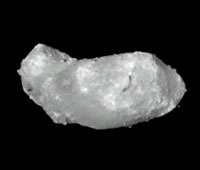Japanese Asteroid Sample-return Spacecraft HAYABUSA Arrives Itokawa

Japanese asteroid sample-return spacecraft Hayabusa arrived Itokawa on 10:00 am, 12 Sep (JST: Japanese Standard Time). Now Hayabusa hovers around 20 kilometers away from asteroid Itokawa. Hayabusa will bring back samples from an asteroid and investigate the mysteries of the birth of the solar system.
This picture was taken at 8:35 am, 12 Sep (JST) just before the settlement by the visible imager AMICA. Field of view is two degrees.
The photo shows contrast of rocky and hilly region and smooth area, which may suggest the origin of this asteroid. This feature may be a key to consider Itokawa’s origin and evolution.
The scientific observation will be conducted for about two months including sampling and topographic measurement.
Color composite image will be available soon.
HAYABUSA’s mission: to bring back samples from an asteroid and investigate the mysteries of the birth of the solar system.
HAYABUSA (MUSES-C) has been developed to investigate asteroids. Asteroids are celestial bodies that are smaller than planets but are part of the solar system. HAYABUSA was launched on May 9th, 2003, and has been flying steadily towards an asteroid named "Itokawa," after the late Dr. Hideo Itokawa, the father of Japan’s space development program. HAYABUSA is traveling through space using an ion engine. It will orbit the asteroid, land on it, and bring back a sample from its surface.
Until now, the only extra-terrestrial celestial body from which we have gathered samples is the Moon. But since the matter that comprises large bodies such as the planets and the Moon has changed over time due to thermal processes, these bodies cannot provide us with a pristine record of the solar system. Asteroids, on the other hand, are believed to be small enough to have preserved the state of the early solar system and are sometimes referred to as celestial fossils. A soil sample from an asteroid can give us clues about the raw materials that made up planets and asteroids in their formative years, and about the state of the inside of a solar nebula around the time of the birth of the planets. However small the sample amount may be, its scientific significance is tremendous.
HAYABUSA’s mission will play an important role in future space-probe journeys.
HAYABUSA employs a new technology - the ion engine. This engine first ionizes the propellant gas, Xenon, then electrically accelerates and emits the ions, to propel itself forward. As it is a highly efficient engine, it is expected to be an important technological tool for our future exploration of the Moon and the planets. HAYABUSA will demonstrate this technology.
Another innovation that HAYABUSA will demonstrate is the Autonomous Navigation System, which enables the probe to approach a far-away asteroid without human guidance. The system works by measuring the distance to the asteroid with the Optical Navigation Camera, and using Light Detection and Ranging.
HAYABUSA will not only gather samples but also observe the asteroid with various scientific devices and measures. For that purpose, it is equipped with a Telescope Wide-View Cameras and Light Detection and Ranging, as well as with a Near Infrared Spectrometer. It will also employ a hopping robot, which can move around on the asteroid’s surface. When HAYABUSA returns to Earth, a re-entry capsule bearing a surface sample from the asteroid will separate from it and plunge into the Earth’s atmosphere. This is also a very important experiment in space engineering.
Source: Japan Aerospace Exploration Agency


















